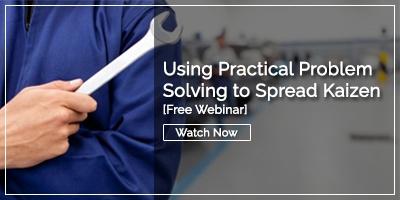
Kaizen management can give your company a significant edge over your competitors. It involves lean operations and continuous improvement, two vital factors to be effective in today’s economy. Another essential component is empowering your team members to participate in finding the opportunity to improve.
Following a kaizen management style involves a shift away from many of the principles of traditional business management models.
What is Kaizen?
The business concept of kaizen comes from the Japanese words for good change. It rests on the idea that continuous improvement is the responsibility of every employee and that by making small changes daily, organizations can inch ever closer to perfection.
The principles of Kaizen are:
- Every process, task, or operation can be improved
- Continuous improvement and the will to solve problems are necessary for survival
- Defects and errors are usually the faults of flawed processes, not people
- Every employee in the organization must be involved in improvement
- Incremental changes made daily can have a significant impact
Kaizen Best Practices
Here are some of the best practices associated with Kaizen:
Focus on the process, not the goal
Process focus might be the most significant difference between kaizen management and traditional management styles. Kaizen is based on a philosophy of slight, incremental, continuous improvement. When this style is fully operational, it creates a self-sustaining cycle of opportunities and solutions to reduce waste of time, money, and resources. Goal-oriented management focuses on control with a limited definition of success, while kaizen is flexible and adaptive. It uses metrics for evaluation rather than to measure the improvements and meet a predefined number. Finally, process-oriented management looks at the big picture, while goal-oriented management is more narrowly focused on the short term.
Engage your employees in the decision-making process
Employees often feel powerless to affect change in their workplaces. They’re your greatest resource for ideas and skills, but they believe their voice isn’t heard. Token attempts at engagement like the typical suggestion box don’t produce any meaningful action. On the other hand, Kaizen management includes employees in the improvement process from identification through implementation to recognition. Seeing their position in the company validated gives them the confidence and motivation to continue looking for more opportunities to improve.
Go after the low-hanging fruit
As mentioned, kaizen management focuses on small, incremental improvement. Employees are encouraged to seek opportunities for change that are low-risk and low-cost. This enables change to be effected quickly, creating a momentum that carries through to the next project. It also keeps the energy level high, providing greater engagement on the part of employees. These changes create the building blocks that form the culture of continuous improvement.
“Do it better, make it better”
Everyone is familiar with the saying, “If it ain’t broke, don’t fix it.” In traditional business models, if a process or system appears to be functioning reasonably well, it’s assumed that it’s operating at maximum effectiveness. Kaizen management assumes that every element of a company can be improved. Employees are encouraged to look at established policies and methods with a fresh eye. Instead of thinking up reasons why something can’t be done, they’re urged to ignore conventional limitations and figure out how it can be done.
Eliminate waste in all forms
For many companies, waste is looked at from a financial perspective. For Kaizen management, waste applies to all resources. One resource that can never be replenished is time. Every action should add some value to the company, and employees are encouraged to look for ways to increase efficiency and reduce waste. The workplace is constantly adjusted to be organized in such a way that no unnecessary steps are taken.
Don't throw money at problems
Some improvements will require capital, but spending money or hiring people is not kaizen’s first line of defense. Instead, the most successful teams use innovation, creativity, and experimentation to improve before writing a check. In fact, budget-constrained organizations have even more reasons to practice Kaizen.
Kaizen Improvement Techniques
In addition to these best practices, some specific techniques can be used to support and spread Kaizen thinking in your organization.
Gemba Walks
During a Gemba walk, a leader goes to the place where work is done to observe and show respect for the employees. The leader asks questions and learns why work is performed in a current manner. After the walk, any opportunities for improvement are documented and potentially implemented.
Hoshin Kanri
Hoshin Kanri is a strategy deployment that helps align individual improvement work with the overall strategy and objectives of the organization. Several breakthrough objectives are identified and then goals cascade down to the individual level.
5S
5S is a workplace organization methodology for ensuring safety and increasing efficiency. 5S stands for the 5 steps: Sort, Set in Order, Shine, Standardize, Sustain. These steps require going through everything in a workspace, deciding what's necessary and what isn't. Necessary things are put things in order, the space is cleaned, and finally set up for efficient workflow.
Value Stream Mapping
Creating a map of the flow of value to a customer is an excellent way to identify potential areas for waste reduction. Every process, activity, and operation is mapped in relation to each other, with dependencies identified. For example, raw materials or ideas are on one end, and the customer is on the other. Every process that is not directly in the flow should be examined strictly to see if it is indispensable.
PDSA
Plan, do, study, and act is a simple improvement cycle for ensuring that changes positively impact results. First, a plan is developed that addresses the root cause of the issue at hand. Next small changes are implemented to attempt to achieve the desired results. Finally, the data is studied to ensure that positive change has occurred. If it has, the change is made part of the standard work.
When people's ideas are the basis of change, they are more motivated to make them successful. That's why no amount of money can overcome the cultural toxins of disengagement and distrust.
Kaizen management is a positive, proactive way of operating a company. What changes could you implement in your organization by adopting this style?




Add a Comment